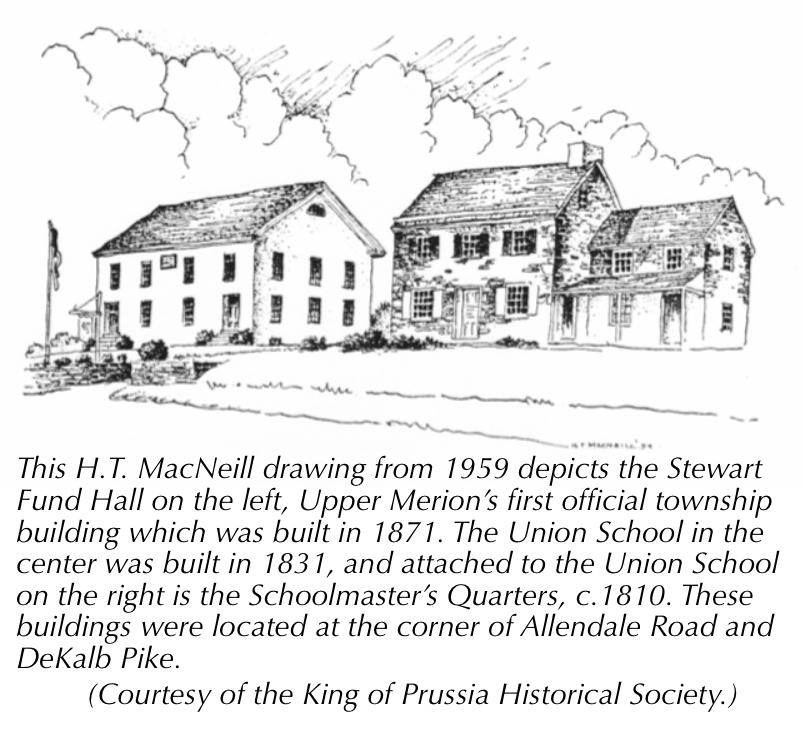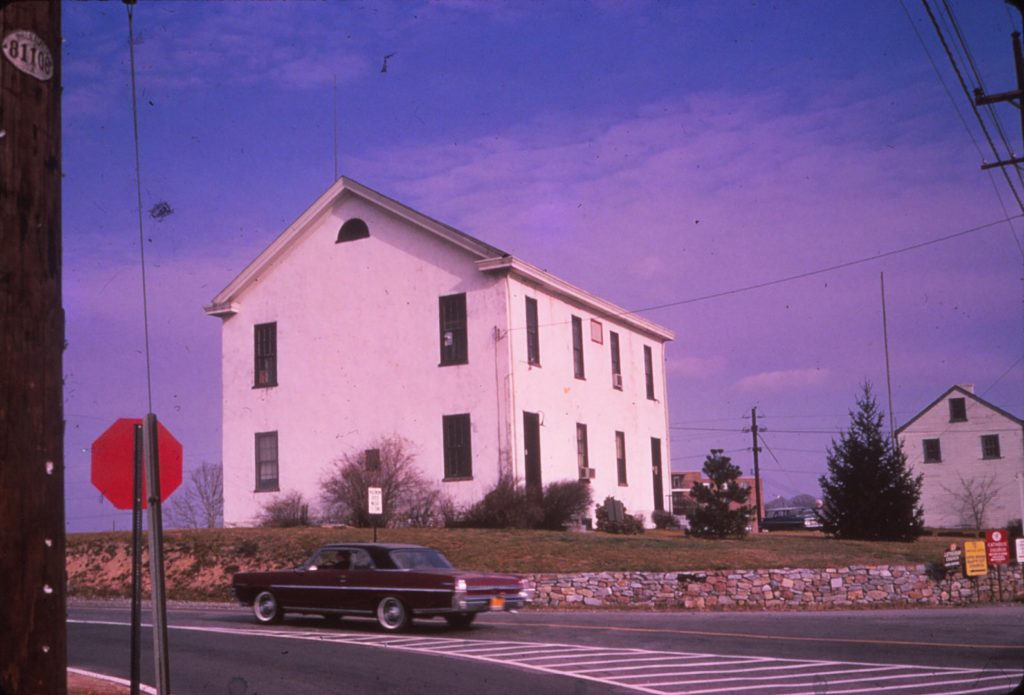Stewart Hall, Township Building, Built in 1879
By Ed Dybicz 1965
In recent weeks the Upper Merion Township building on Swedesburg Rd., King of Prussia, formerly known as “Stewart Fund Hall’, has been in the news.
The building has been described as being inadequate for the proper administration of township governmental functions.
No one doubts that Upper Merion needs a new township facility. As a matter of fact, Township Manager Robert W. Geerdes calls it a “fire hazard” according to a recent report in the Valley Forge Life.
Five sites are under consideration. Some citizens have on occasion advocated the use of the former Junior-Senior High School on Gulph and Henderson Roads, Gulph Mills, as a municipal building to also accommodate the police department. These premises are now used by the Penn State University.
Upper Merion Supervisors made known to the public that funds toward future construction have been earmarked for a building reserve fund.
The Stewart Fund Hall, present township building, was erected in 1879 as an outgrowth of a legacy for educational purposes left by the will of William Stewart, who died in 1808, according to records of the Historical Society of Montgomery County.
At first, the income was applied to the Union School at King of Prussia. A surplus accumulated which made it possible to have the hall built in 1879.
It came into general use for many community purposes. There was a public library, occasional lectures, a meeting place for the grange, a literary society, a building and loan association, in addition to an old time Union Sunday School for families of all denominations.
In June of 1923, the Stewart Fund Hall was also wrecked by fire. Flames were coming out windows when fire companies from Swedeland, Bridgeport, Wayne and Norristown arrived on the scene. Firemen pumped water from a nearby creek to save the building.
The hall was maintained by a group of trustees elected yearly until 1947 when the building was sold to the township and converted to its present status. A police station was located in the hall, but because of the expansion of the department, and cramped quarters, was moved to a former dwelling a short distance away on Allendale Rd.
The King of Prussia Fire Co. was organized in this building at a public meeting in July of 1950.
Also, Trinity Lutheran Church of Norristown, endeavoring to meet the needs of the many families that have settled in the communities in that part of Upper Merion, held Sunday School in the hall.
This episode also recalls that once before Trinity Lutheran Church started a Sunday School West of the Schuylkill. This was in 1906. Sessions were held in Market Hall, Bridgeport. The pastor of Trinity Church at that time was the Rev. Dr. Ernst P. Pfatteicher, later president of the Lutheran Ministerium of Pennsylvania, and he was keenly interested in fostering the Bridgeport mission.
It was expected that before many years passed a church could be built, and a site for it was bought at DeKalb and Fifth Streets. A name was adopted for the contemplated congregation — “St. Luke’s”. However, the undertaking failed to prove encouraging and it was abandoned after some years, the lot being sold in 1914.
Upper Merion now has a Lutheran Church, called the “Good Shepard” and located on West Valley Forge Road, Belmont Terrace.
The first place of worship in Upper Merion Township was a Lutheran enterprise — Swedish Lutheran — and it survives today as Christ Church, Old Swedes, situated in the community of Swedesburg.
Up, until 1957, the parish retained the original charter name of Swedish Lutheran Church of Upper Merion Township. That year, it transformed into an Episcopal Parish, joining the Episcopal Diocese.
Lutheranism was the state religion of Sweden and it sent ministers to America for its missions far back in the 18th century. Establishment of American Independence put an end to the sending of clergy from Sweden. The Lutheran Churches of German origin made no effort to supply English-speaking ministers, the Swedish churches, now generally using the English language, accepted clergymen from the Episcopal denomination.
The last Swedish minister, Rev. Nicholas Collin, died in 1831. Ten years later, the three Swedish churches in Pennsylvania, that in Upper Merion, the oldest in South Philadelphia, and another in West Philadelphia, dissolved that union in which they had been associated and each obtained a new charter. That of the Upper Merion church in Swedesburg, called it Swedish Lutheran and empowered the congregation to choose clergy either from the Lutheran or the Episcopal clergy declared invalid. But the judges in 1847 declined to intervene. Again the question was brought into court in 1853, an injunction against Episcopal services being sought. Judge Smyser upheld the validity of the church’s charter.
In 1956, Christ Church, Old Swedes, severed its Lutheran ties and became a part of the Episcopal Diocese.


